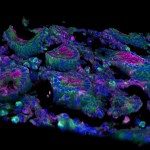Link to Pubmed [PMID] – 30794328
Link to DOI – 10.1002/JLB.4A1018-391RR
J Leukoc Biol 2019 05; 105(5): 1055-1073
A better understanding of innate responses induced by vaccination is critical for designing optimal vaccines. Here, we studied the diversity and dynamics of the NK cell compartment after prime-boost immunization with the modified vaccinia virus Ankara using cynomolgus macaques as a model. Mass cytometry was used to deeply characterize blood NK cells. The NK cell subphenotype composition was modified by the prime. Certain phenotypic changes induced by the prime were maintained over time and, as a result, the NK cell composition prior to boost differed from that before prime. The key phenotypic signature that distinguished NK cells responding to the boost from those responding to the prime included stronger expression of several cytotoxic, homing, and adhesion molecules, suggesting that NK cells at recall were functionally distinct. Our data reveal potential priming or imprinting of NK cells after the first vaccine injection. This study provides novel insights into prime-boost vaccination protocols that could be used to optimize future vaccines.


